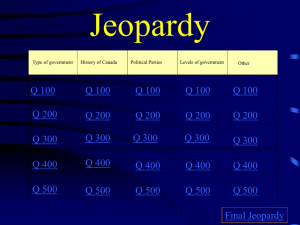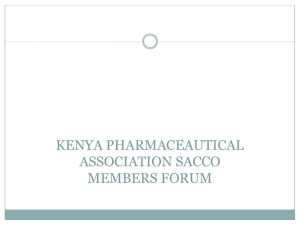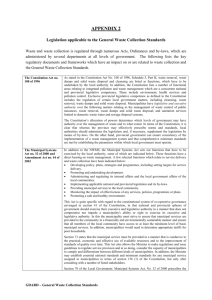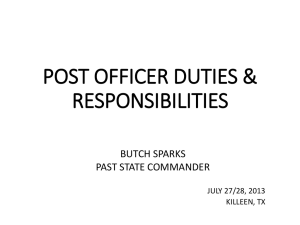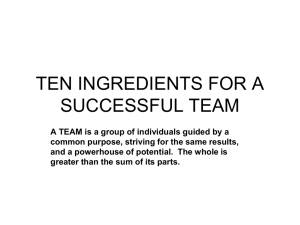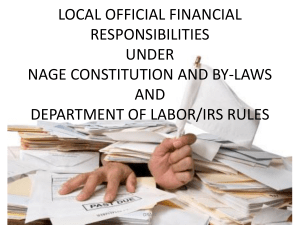City of Johannesburg Metropolitan Municipality
advertisement
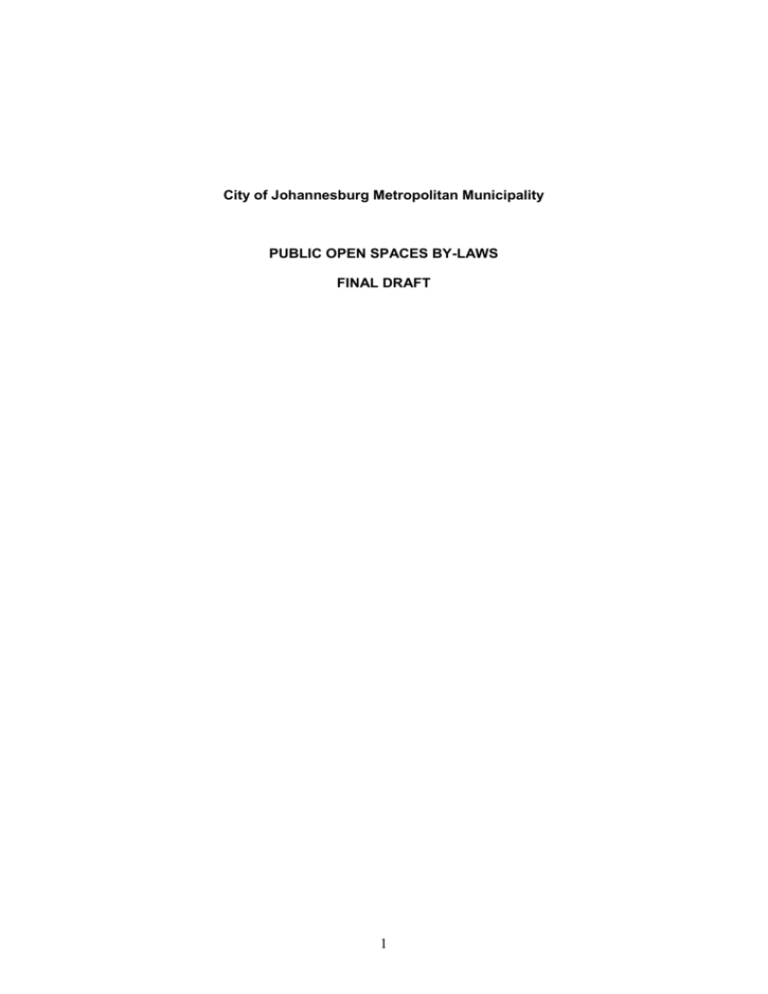
City of Johannesburg Metropolitan Municipality PUBLIC OPEN SPACES BY-LAWS FINAL DRAFT 1 CITY OF JOHANNESBURG METROPOLITAN MUNICIPALITY PUBLIC OPEN SPACES BY-LAWS The Municipal Manager of the City of Johannesburg Metropolitan Municipality hereby, in terms of Section 13(a) of the Local Government: Municipal Systems Act, 2000 (Act No 32 of 2000), publishes the Public Open Spaces By-laws for the City of Johannesburg Metropolitan Municipality, as approved by its Council, as set out hereunder. CITY OF JOHANNESBURG METROPOLITAN MUNICIPALITY PUBLIC OPEN SPACES BY-LAWS TABLE OF CONTENTS CHAPTER 1 INTERPRETATION AND FUNDAMENTAL PRINCIPLES 1. 2. 3. Definitions and interpretation Application of By-laws Purpose of By-laws CHAPTER 2 MANAGEMENT AND ADMINISTRATION OF PUBLIC OPEN SPACES 4. 5. 6. 7. 8. 9. 10. Principles of By-laws Application of principles General powers of Council Fees Restricting access Powers of authorised officials Obligations in relation to public open spaces CHAPTER 3 PROHIBITED CONDUCT 11. 12. 13. 14. 15. 16. 17. Prohibited activities General prohibition Prohibited use Waste Vehicles Vegetation and animals Municipal property and erection of structures 2 18. 19. 20. Selling and special events Community service Restoration or removal notices CHAPTER 4 APPLICATIONS FOR AUTHORISATION 21. 22. 23. Application for permission Application for a special event permit Application for permission to farm in an urban agricultural public open space CHAPTER 5 CO-OPERATIVE MANAGEMENT AGREEMENTS 24. Entering into agreements CHAPTER 6 TREE PRESERVATION ORDERS 25. 26. General Procedure CHAPTER 7 MISCELLANEOUS 27. 28. 29. Offences and penalties Repeal Short Title SCHEDULE Repealed By-laws CHAPTER 1 INTERPRETATION AND FUNDAMENTAL PRINCIPLES Definitions and interpretation 1. (1) In these By-laws, unless the context otherwise indicates – “active game” means any physical sport, game or other activity participated in by one or more persons which is undertaken within a public open space other than in an area set aside for that purpose, and which may cause injury to other users of the public open space, a nuisance or damage to vegetation or municipal property within a public open space and includes rugby, golf, archery, football, tennis, badminton, hockey, netball, volleyball, skateboarding, roller-skating and in-line skating; “authorised official” means any official of the Council who has been authorised by the Council to administer, implement, and enforce the provisions of these By-laws; “conservation public open space” means public open space which is managed by or on behalf of the Council for conservation purposes, and includes any nature reserve, greenbelt, ravine, bird sanctuary and site of historic, ecological or archaeological value; 3 “Council” means – (a) the Metropolitan Municipality of the City of Johannesburg established by Provincial Notice No 6766 of 2000 dated I October 2000, as amended, exercising its legislative and executive authority through its municipal Council; or (b) its successor in title; or (c) a structure or person exercising a delegated power or carrying out an instruction, where any power in these by-laws has been delegated or sub-delegated, or an instruction given, as contemplated in section 59 of the Local Government: Municipal Systems Act, 2000 (Act No 32 of 2000); or (d) a service provider fulfilling a responsibility under these by-laws, assigned to it in terms of section 81(2) of the Local Government: Municipal Systems Act (Act No. 32 of 2000) or any other law, as the case may be. “designated area” means an area designated by the Council as an area in which an active game or any other activity or conduct, which would otherwise be prohibited under Chapter 3 of these By-laws, may be undertaken; “environment” means the surroundings within which humans exist and that are made up of – (a) the land, water and atmosphere of the earth; (b) micro-organisms, plant and animal life; (c) any part or combination of paragraphs (a) and (b) and the interrelationships among and between them; and (d) the physical, chemical, aesthetic and cultural properties and conditions of the foregoing that influence human health and wellbeing; “environmentally sustainable” means the exercising of any decision-making powers or performance of any activities in a manner aimed at ensuring that – (a) the risk of harm to the environment and to human health and safety is minimised to the extent reasonably possible under the circumstances; (b) the potential benefits to the environment and to human health and safety are maximised to the extent reasonably possible under the circumstances; and (c) legislation intended to protect the environment and human health and safety is complied with; “local community” means that body of persons comprising – (a) the residents of the area in which a public open space is situated; (b) the ratepayers of the area in which a public open space is situated; and (c) any civic organisation and non-governmental or private sector organisation or body which are involved in local affairs in the area in which a public open space is situated; “municipal manager” means a person appointed as such by the Council in terms of section 82 of the Local Government: Municipal Structures Act, 1998 (Act No 117 of 1998); 4 “municipal property” means any structure or thing owned or managed by or on behalf of the Council and which is incidental to the use and enjoyment of a public open space and includes any building, lapa, kiosk, bench, picnic table, playground equipment, fountain, statue, monument, fence, pole, notice and sign; “notice” means a clear and legible official notice drawn up by the Council in English and Afrikaans and prominently displayed in a public open space; “nuisance” means an unreasonable interference or likely interference with– (a) the health or well-being of any person; (b) the use and enjoyment by an owner or occupier of his or her property; or (c) the use and enjoyment by a member of the public of a public open space; “organ of State” means – (a) any department of State or administration in the national, provincial or local sphere of government; and (b) any other functionary or institution – (i) exercising a power or performing a function in terms of the Constitution of the Republic of South Africa Act, 1996 (Act No. 108 of 1996) or a provincial Constitution; or (ii) exercising a public power or performing a public function in terms of any legislation, but does not include a court of law and a judicial officer; “person” means a natural person or a juristic person, and includes an organ of State; “prescribed fee” means a fee determined by the Council by resolution in terms of section 10G(7)(a)(ii) of the Local Government Transition Act, 1993 (Act No. 209 of 1993), or any other applicable legislation; “printed matter” includes any advertisement, billboard, poster, book, pamphlet or handbill; “prohibited activity” means any activity or behaviour which is prohibited in terms of Chapter 3 from being undertaken in a public open space, either completely or without permission in terms of section 21, 22 or 23; “public open space” means any land which – (a) is owned by an organ of State, or (b) over which an organ of State has certain real rights arising from the filing in the Deeds Office or other registration office of a general plan of a township, agricultural holding or other division of land, or any alteration, addition to or amendment of such land approved by the Surveyor-General, on which is marked the land to which the public has a common right of use; and (c) is controlled and managed by the Council; and (d) is either – 5 (i) set aside in terms of any law, zoning scheme or spatial plan, for the purpose of public recreation, conservation, the installation of public infrastructure or agriculture; or (ii) predominantly undeveloped and open and has not yet been set aside for a particular purpose in terms of any law, zoning scheme or spatial plan; “public utility public open space” means public open space which is managed by or on behalf of the Council for the purposes of providing a public service, which includes road reserves and areas subject to electrical, pipeline and other public utility servitudes, but excludes council housing, clinics and other social services; “recreational public open space” means public open space which is managed by or on behalf of the Council for public recreational purposes, and includes any park, botanical garden, sportsground and playground, but excludes any golf course; “road reserve” means that portion of a road, street or thoroughfare improved, constructed or intended for vehicular traffic and which is between the edges of the roadway and that portion of a road, street or thoroughfare, including the sidewalk, which is not the roadway or shoulder; “special event” means a parade, procession, race, concert, show, exhibition, festival, ceremony, film shoot, photographic shoot or similar event, which requires, for that purpose, exclusive use of a part of a public open space; “urban agricultural public open space” means public open space which is managed by or on behalf of the Council for urban agricultural purposes; “vehicle” means a device designed or adapted mainly to travel on wheels, but excludes a wheelchair and children’s pushchair and perambulator; “waste” means any substance or article which a person wishes to dispose of because it is unwanted, superfluous, broken, worn out, contaminated or otherwise spoilt and that has been discarded or has been accumulated or stored so that it can be discarded, reused, reclaimed or recycled; “watercraft” includes any boat, raft, yacht, canoe, inflatable mattress, model ship or boat, radio-controlled boat or similar device; “water body” means any body of water within a public open space and includes a pond, fountain, artificial watercourse, dam, lake, canal, reservoir, stream, river and wetland. (2) If any provision in these By-laws vests or imposes any power, function or duty of the Council in or on an employee of the Council and such power, function or duty has in terms of section 81(2) of the Local Government: Municipal systems Act, 2000, or any other law been assigned to a service provider, the reference in such provision to such employee must be read as a reference to the service provider or, where applicable, an employee of the service provider authorised by it. Application of By-laws 6 2. (1) These By-laws apply to every public open space which falls under the jurisdiction of the Council, but do not apply to cemeteries. (2) These By-laws are binding on the State. Purpose of By-laws 3. The purpose of these By-laws is to provide, in conjunction with other applicable legislation, an effective legal and administrative framework(a) to ensure that the way in which the Council controls, manages and develops public open spaces is environmentally sustainable, and is in the long-term interests of the whole community of Johannesburg, including future generations; and (b) which clearly defines the rights and obligations of the public in relation to public open spaces. CHAPTER 2 MANAGEMENT AND ADMINISTRATION OF PUBLIC OPEN SPACES Principles of By-laws 4. (1) Public open spaces must be managed, and where appropriate developed, in the interests of the whole community, and in determining the interests of the whole community – (a) the long-term collective interests of the people of Johannesburg, and of South Africa, must be prioritised over the interests of any specific interest group or sector of society; (b) a long-term perspective, which takes account the interests of future generations, must be adopted; and (c) the interests of other living organisms which depend on public open spaces must be taken into account. (2) Public open spaces must be managed in an environmentally sustainable manner. (3) Subject to the provisions of subsection (5) and section 7, people must be given access to public open spaces on a non-discriminatory and equitable basis. (4) If necessary, special measures must be taken to facilitate access to public open spaces by historically disadvantaged persons and by disabled persons. (5) Access to a public open space may be restricted in a manner which does not unjustifiably discriminate against any person or class of persons– (a) if the restriction is authorised by these By-laws or by any other law; or (b) in order to achieve the purposes of these By-laws. (6) The recreational, educational, social and other opportunities which public open spaces offer must be protected and enhanced to enable local communities, particularly historically disadvantaged communities, and the public to improve and enrich their quality of life. 7 (7) Local communities must be encouraged to use and care for public open spaces in their areas. (8) The natural environment and heritage resources within public open spaces must be identified, preserved, protected and promoted, for the benefit of the local community, the public and future generations. Application of principles 5. The public open space management principles set out in section 4, and the national environmental management principles set out in section 2 of the National Environmental Management Act, 1998 (Act 107 of 1998), must be considered and applied by any person – (a) exercising a power or function or performing a duty under these By-laws; (b) formulating or implementing any policy which is likely to have a significant effect on, or which concerns the use of, public open spaces within the Council’s jurisdiction; or (c) exercising a public power or function or performing a public duty which is likely to have a significant effect on, or which concerns the use of, public open spaces. General powers of Council 6. The Council may in relation to any public open space – (a) designate any area within a public open space as an area within which one or more activities otherwise prohibited in terms of these By-laws may be undertaken, and display a prominent notice to this effect at every entrance to the designated area; (b) develop any public open space in accordance with the principles set out in section 4; (c) erect, construct, establish or demolish municipal property; and (d) exercise any other power reasonably necessary for the discharge of the Council’s obligations in terms of these By-laws relating to the management of public open spaces. Fees 7. Any member of the public must pay – (a) a prescribed fee to use recreational or other facilities which the Council provides within any public open space; (b) a prescribed fee for entrance to any public open space which is significantly more expensive to maintain than other public open spaces, such as botanical gardens; (c) a prescribed fee for the right to undertake a special event; (d) a prescribed fee for the right to exclusively use municipal property for a specific period; (e) a deposit prior to undertaking a prohibited activity permitted by the Council; (f) an annual or monthly fee for the right to use urban agricultural public open space to the exclusion of any other person; and 8 (g) a prescribed fee for processing applications for permits or letters of permission under these By-laws, if such a fee or deposit has been determined by the Council. Restricting access 8. The Council may restrict access to any public open space or to any part of a public open space for a specified period of time – (a) to protect any aspect of the environment within a public open space; (b) to reduce vandalism and the destruction of property; (c) to improve the administration of a public open space; (d) to develop a public open space; (e) to enable a special event which has been permitted in terms of section 22, to proceed; or (f) to undertake any activity which the Council reasonably considers necessary or appropriate to achieve the purposes of these Bylaws. Powers of authorised officials 9. In relation to any public open space, an authorized official may – (a) to the extent authorised by the Council administer, implement and enforce the provisions of these By-laws; (b) issue a notice in terms of section 20; (c) instruct any person to leave a public open space if the authorized official reasonably believes that the person is contravening any provision of these By-laws, and fails to immediately terminate such contravention upon the instruction of that official; and (d) if such official is a peace officer, exercise any power which may be exercised by a peace officer under the Criminal Procedure Act, 1977 (Act No. 51 of 1977). Obligations in relation to public open spaces 10. (1) The Council must within a public open space display any notice required under these By-laws. (2) In relation to recreational public open spaces, the Council must – (a) ensure that they are open to the public between sunrise and sunset, unless specified otherwise in terms of a notice; and (b) prominently display a notice at every entrance indicating: (i) the opening and closing times of that recreational public open space; and (ii) any rules made by the Council in relation to that recreational public open space. 9 CHAPTER 3 PROHIBITED CONDUCT Prohibited activities 11. (1) Any person who undertakes an activity or behaves in a manner that is prohibited in terms of these By-laws, commits an offence unless, in addition to any exceptions contained in sections 12 to 19, that activity or conduct– (a) takes place in a designated area within which that activity or conduct is allowed; or (b) is authorised in terms of a permission granted or permit issued in terms of section 21, 22 or 23; or (c) is deemed to be authorised by the Council under subsection (2). (2) Subject to the provisions of subsection (3), a person is not in contravention of any provision of section 12 to 19 if that person needs to undertake the prohibited activity – (a) to perform his or her obligations as an employee, agent or contractor of the Council under his or her contract with, or mandate from, the Council or to achieve the purposes of these Bylaws; (b) to carry out public duties as an employee, agent or contractor of an organ of State within a public open space which is subject to a public utility servitude in favour of that organ of State; (c) to fulfil his or her duties as an authorised official; or (d) to fulfill his or her duties as a peace officer. (3) Subsection (2) must not be interpreted to allow a contravention of section 12(a) or (e) or any activity which the Council has expressly refused to permit. General prohibition 12. No person may within a public open space – (a) act in a manner which is dangerous to life or property; (b) contravene the provisions of any notice within any public open space; (c) unlawfully enter a public open space to which access has been restricted in terms of section 8; (d) cause a nuisance; or (e) behave in an indecent or offensive manner. Prohibited use 13. No person may within a public open space – (a) bathe, wade, or swim in or wash him- or herself, an animal or any object, including clothing, in any water body; (b) make, light or otherwise start a fire except in a facility provided by the Council for that purpose; (c) camp or reside; 10 (d) consume, brew, store or sell any alcoholic beverage; (e) use any sound equipment, including a radio, portable hi-fi or car stereo; (f) play an active game, except in an area designated for that purpose on a sport playing field or on a golf course; or (g) shoot a projectile of any nature. Waste 14. No person may within a public open space – (a) deposit, dump or discard any waste, other than in a receptacle provided by the Council for that purpose; or (b) pollute or deposit any waste or thing in a manner which may detrimentally impact on a water body. Vehicles 15. No person may within a public open space – (a) except at times specified and on roads or pathways provided by the Council, drive, draw or propel any vehicle other than a bicycle; (b) drive, draw or propel a vehicle in excess of five kilometres per hour; or (c) park a vehicle in a public open space, except in designated area or other area where parking is otherwise permitted by the Council. Vegetation and animals 16. (1) Subject to the provisions of subsection (2), no person may within a public open space – (a) disturb, damage, destroy or remove any tree, shrub or other vegetation; (b) affix or place any printed matter on a tree; (c) plant any vegetation; (d) alter the slope or drainage pattern so as to interfere with the access of water, air or nutrients to any tree or other plant; (e) capture or attempt to capture, chase, shoot at, injure, throw objects at, tease, molest or in any other way disturb any animal, fish, or bird; (f) disturb, damage or destroy any bird nest or egg; (g) ride a horse, except(i) in a public open space or any part thereof designated by the Council for that purpose; and (ii) a person who in the performance of his or her official duties, patrols a public open space on horseback; (h) walk, carry, ride or bring an animal other than a horse or dog; or (i) walk any dog unless- 11 (i) it is in a public open space or any part thereof which has not been designated by the Council as an area where no dogs are allowed, and it is on a leash and under control of a person; or (ii) it is in a public open space or any part thereof designated by the Council as an area where dogs may run free: Provided that if any dog excretes in a public open space, the person in control of the dog must immediately remove such excrement and dispose of it in a waste bin or other receptacle provided by the Council for that purpose. (2) The provisions of subsection (1)(a) and (c) do not apply to any person who has obtained a permit in terms of section 23 to undertake agricultural activities in an urban agricultural public open space. Municipal property and erection of structures 17. (1) Subject to the provisions of subsection (2), no person may within a public open space – (a) deface, damage, destroy or remove any municipal property; (b) disturb the surface of any land, whether by digging, undertaking any earthworks or otherwise; (c) erect, build or assemble any structure, including a hut, tent, screen, bulletin board, pole, stand or stage; (d) affix or place on any municipal property, or distribute, any printed matter; or (e) plug, tamper with, or in any way damage any plumbing, electrical, heating or other fixtures or installations. (2) The provisions of subsection (1)(b) do not apply to any person who has obtained a permit in terms of section 23 to undertake agricultural activities in an urban agricultural public open space. Selling and special events 18. (1) No person may within a public open space – (a) use municipal property in a way that unfairly restricts or prevents other users of the public open space from enjoying that municipal property; or (b) except within a public open space or part thereof, which has been let to a person by the Council for that purpose, sell, hawk, offer or display any goods or articles for sale or hire; (2) No person may undertake a special event, except in terms of a permit issued in terms of section 22. Community service 19. Except in terms of an agreement entered into in terms of section 24, no person may within a public open space undertake any community or voluntary work of any description. 12 Restoration or removal notices 20. (1) Unless permission or a permit to do so has been obtained in terms of section 21, 22 or 23, an authorised official may issue a restoration or removal notice to any person who has in a public open space – (a) damaged, defaced, disturbed, destroyed, demolished or removed vegetation or a municipal structure; (b) erected, built or assembled a structure; or (c) dumped, discarded or deposited any waste, other than in a receptacle provided by the Council for that purpose. (2) The restoration or removal notice may direct the person concerned within a reasonable time specified in the notice to take stated reasonable steps specified in the notice(a) to restore or rehabilitate the affected area to the reasonable satisfaction of the Council; or (b) to remove a structure or thing and restore the affected site, as nearly as practicable, to its former condition. CHAPTER 4 APPLICATIONS FOR AUTHORISATION Application for permission 21. (1) Any person who wants to undertake a prohibited activity must make application in writing to the Council for permission to do so, which application must be accompanied by the prescribed fee. (2) The Council may, after receiving an application, request the applicant to provide additional information which the Council reasonably requires in order to consider the application. (3) The Council may refuse to consider an application until it has been provided with the information that it reasonably requires to make an informed decision and if the prescribed fee has not been paid. (4) Subject to the provisions of subsections (2) and (3), the Council must consider the application within a reasonable time and must either(a) refuse the application; or (b) grant permission in writing to the applicant subject to such conditions as the Council may consider appropriate to best achieve the purposes of these By-laws, which may include payment of a deposit, a prescribed fee or both. (5) The Council may not grant permission for any person to behave in a manner which is prohibited in terms of section 12(a) or (e). Application for a special event permit 22. (1) An application for permission to hold a special event in a public open space must be made at least 21 days prior to the proposed date of the special event. 13 (2) The time period referred to in subsection (1) may, on good cause shown, be reduced by the Council. (3) An application in terms of subsection (1), must contain the following information: (a) The name and full contact details of the applicant, including name, postal address, telephone and fax numbers and email address, if available; (b) the nature and purpose of the special event; (c) the intended route or area proposed to be used for purposes of the special event; and (d) any permission required under Chapter 3 of these By-laws. (4) Subject to any permit conditions imposed by the Council, the holder of a special events permit has the right to use the area of public open space specified in the permit to the exclusion of any other person during the period specified in the permit. Application for permission to farm in an urban agricultural public open space 23. (1) An application for permission to farm in an urban agricultural public open space must contain the following information: (a) The name and full contact details of the applicant, including name, postal address, telephone and fax numbers and email address, if available; (b) the nature of the agricultural activity that the applicant proposes to undertake; and (c) the size and location of the area on which the applicant wishes to undertake the proposed agricultural activity. (2) A permit under this section may require the permit holder to pay an annual or monthly fee for the use of the land. (3) The holder of an urban agricultural permit may, subject to any condition specified in the permit, use the area of public open space specified in the permit for agricultural purposes to the exclusion of any other person. CHAPTER 5 CO-OPERATIVE MANAGEMENT AGREEMENTS Entering into agreements 24. (1) The Council may enter into a written agreement with any organ of State, local community or organization to provide for – (a) the co-operative development of any public open space; or (b) the co-operative management of any public open space; and (c) the regulation of human activities within a public open space. 14 (2) The Council may not enter into an agreement in terms of subsection (1) (b) unless it reasonably believes that entering into such an agreement will promote the purpose of these By-laws. (3) The Council must monitor the effectiveness of any agreement entered into in terms of subsection (1), in achieving the purposes for which it was entered into and may cancel the agreement after giving reasonable notice to the other party if the Council has reason to believe that the agreement is not effective, or is inhibiting the attainment of the purpose of these By-laws. CHAPTER 6 TREE PRESERVATION ORDERS General 25. (1) If the Council believes that any tree or group of trees in a public open space requires legal protection the Council may issue a tree preservation order in respect of that tree or group of trees. (2) A tree preservation order(a) must indicate the tree or trees to which it relates; and (b) may provide that any person who cuts, disturbs, damages, destroys, removes, transports, exports, purchases, sells, donates or in any other manner acquires or disposes of the tree or trees to which it relates, commits an offence. (3) The Council must prominently display a copy of a tree preservation order issued within 3 metres of the tree or trees to which the order relates. Procedure 26. Unless, in the Council’s opinion, the issuing of a tree preservation order is required as a matter of urgency, the Council must, before issuing a tree preservation order in terms of section 25– (a) give notice of the proposal to protect the tree or group of trees and invite comments and objections within a specified period, by publishing a notice in the Provincial Gazette and in two newspapers circulating in the area in which the tree or group of trees is situated; (b) notify any affected organs of State; and (c) consider any comments and objections received in response to the notice. CHAPTER 7 MISCELLANEOUS Offences and penalties 27. (1) Any person who – 15 (a) contravenes or fails to comply with any provisions of these Bylaws; (b) fails to comply with any notice or other document issued or displayed in terms of these By-laws; (c) fails to comply with any lawful instruction given in terms of these By-laws; or (d) obstructs or hinders any authorised official in the execution of his or her duties under these By-laws is guilty of an offence and liable on conviction to a fine or in default of payment to imprisonment for a period not exceeding six months and in the case of a continuing offence, to a further fine not exceeding R50, or in default of payment to imprisonment not exceeding one day, for every day during the continuance of such offence after a written notice has been issued by the Council and served on the person concerned requiring the discontinuance of such offence. Repeal 28. The laws listed in the Schedule to these By-laws are hereby repealed. Short Title 29. These By-laws are called the Public Open Spaces By-laws, 2003. 16 SCHEDULE REPEALED BY-LAWS Number and Year Administrator’s Notice 50 dated 23 January 1963 Administrator’s Notice 166 dated 2 February 1972 Administrator’s Notice 1540 dated 4 September 1974 Administrator’s Notice 2176 dated 28 November 1984 Local Authority Notice 365 dated 23 January 1991 Name of By-laws Transvaal Board for the Development of Peri-Urban Areas: By-laws Relating to Parks, Gardens, Pleasure Resorts and Open Spaces as applied by Midrand Municipality Johannesburg Municipality: Parks, Gardens and Open Spaces By-laws Randburg Municipality: By-laws for the Regulation of Public Amenities Roodepoort Municipality: By-laws for the Regulation of Parks, Open Spaces, Dams and Conservation Areas Sandton Municipality: Adoption of Standard Public Amenities By-laws 1 Extent of Repeal Whole Whole Whole Whole Whole
